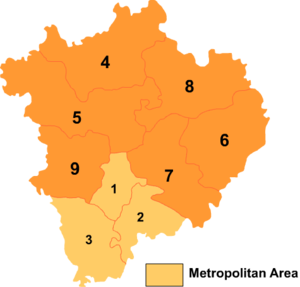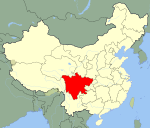- Nanchong
-
Nanchong
南充— Prefecture-level city — 南充市 Nickname(s): The fruit City Coordinates: 31°15′00″N 106°14′00″E / 31.25°N 106.2333333°ECoordinates: 31°15′00″N 106°14′00″E / 31.25°N 106.2333333°E Country China Province Sichuan Officiated 1993 Government – Party Secretary Liu Hongjian Area – Total 12,479 km2 (4,818.2 sq mi) Elevation 340 m (1,115 ft) Population [1] – Total 7,300,000 – Density 585/km2 (1,515.1/sq mi) Time zone UTC (UTC+8) Postal code 637000 Area code(s) 0817 Website http://www.nanchong.gov.cn/ Nanchong (Chinese: 南充; pinyin: Nánchōng; Wade–Giles: Nan-ch'ung ) is a prefecture-level city in the northeast of Sichuan Province of the People's Republic of China, with an area of 12,479 kilometers[2]. and the home to 7,300,000 people. It has the second most populated area and suggested to be one of the eight largest cities of Sichuan Province. The administrative center is Shunqing District.
Contents
History
Nanchong was in the territory of the state of Ba before it was conquested by the Qin dynasty in 314 BC. The Qin set up a government at Langzhong city. Anhan city was established in Shunqinq district at the beginning of the Han Dynasty.
The name of Anhan city was changed to Guozhou (fruit city) in 621 AD (Tang dynasty), and then to Nanchong in 742 AD.
Subdivisions
Map 
# Name Hanzi Hanyu Pinyin Population (2004 est.) Area (km²) Density (/km²) 1 Shunqing District 顺庆区 Shùnqìng Qū 620,000 545 1,138 2 Gaoping District 高坪区 Gāopíng Qū 570,000 812 702 3 Jialing District 嘉陵区 Jiālíng Qū 680,000 1,170 581 4 Langzhong City 阆中市 Lángzhōng Shì 860,000 1,877 458 5 Nanbu County 南部县 Nánbù Xiàn 1,240,000 2,305 538 6 Yingshan County 营山县 Yíngshān Xiàn 900,000 1,633 551 7 Peng'an County 蓬安县 Péng'ān Xiàn 680,000 1,334 510 8 Yilong County 仪陇县 Yílǒng Xiàn 1,060,000 1,695 625 9 Xichong County 西充县 Xīchōng Xiàn 640,000 1,108 578 Geography
Nanchong is located in the north-east of Sichuan Province. To the east of Nanchong is Dazhou, to the west are Mianyang and Suining and to the north is Guangyuan.
The vast majority of this area is hilly. The woodland coverage is 25%.
The Jialing River, a tributary of the Yangtze River, crosses the prefecture from north to south, and there are another thirty rivers in the prefecture with a drainage basin of more than {{convert|30 sq kilometers.
Nanchong has a monsoon-influenced and generally humid and mild—except during summer—climate. It is classified as being humid subtropical (Köppen Cwa). Winters are mild and comparatively dry yet dreary, while summers are long, hot, humid, and much sunnier. January averages 6.4 °C (43.5 °F), while August averages 27.5 °C (81.5 °F); the annual mean temperature is 17.3 °C (63.1 °F). Rainfall is greatest in the summer months
Climate data for Nanchong (1971–2000) Month Jan Feb Mar Apr May Jun Jul Aug Sep Oct Nov Dec Year Average high °C (°F) 9.2
(48.6)11.7
(53.1)16.4
(61.5)22.3
(72.1)26.6
(79.9)28.9
(84.0)31.5
(88.7)32.4
(90.3)26.5
(79.7)21.1
(70.0)16.0
(60.8)10.5
(50.9)21.09
(69.97)Average low °C (°F) 4.3
(39.7)6.1
(43.0)9.7
(49.5)14.2
(57.6)18.4
(65.1)21.5
(70.7)23.8
(74.8)23.7
(74.7)19.9
(67.8)15.4
(59.7)10.6
(51.1)6.0
(42.8)14.47
(58.04)Precipitation mm (inches) 16.2
(0.638)16.9
(0.665)30.3
(1.193)75.1
(2.957)118.4
(4.661)147.2
(5.795)188.3
(7.413)125.9
(4.957)135.5
(5.335)78.1
(3.075)37.3
(1.469)18.0
(0.709)987.2
(38.866)% humidity 85 81 77 76 75 79 80 76 82 84 84 86 80.4 Avg. precipitation days (≥ 0.1 mm) 8.9 8.6 10.7 12.5 13.5 13.6 12.8 10.1 14.6 14.0 10.6 8.3 138.2 Sunshine hours 31.7 43.6 81.7 118.4 130.7 122.6 168.6 193.8 96.5 67.5 53.3 26.9 1,135.3 Source: China Meteorological Administration Demographics
The Han people are the largest ethnic group in this area, contributing to 99.88% of its total population, another 48 ethnic groups can be found in the city. Langzhong has a large Hui Muslim community.
As other cities in China, population in Nanchong is divided to two level, upper urban population and lower rural population, the registered urban population is about 1.2 million.
Shunqing District, located downtown, is the most dense area in Nanchong. At the center of Shunqing District, and the proverbial heart of the city, is Five Star Garden (simplified Chinese: 五星花园); a large roundabout with five exits leading to various other sections of the city.
Economy
Agriculture
Agriculture is the pillar of Nanchong’s economy, with 80% of Nanchong’s population sited in rural area and committed to traditional agriculture activities. Nanchong’s manufacturing industry also relies on raw materials which is provided by agriculture. Nanchong’s main agricultural product is food. A large quantity of rice, orange, silk worms, and pork are produced to support related manufacturers.[3]
Manufacturing
Nanchong’s main manufacturing outputs are petroleum products, automobiles and parts, mechanical equipment, textiles, and building materials. [4]
Natural Resources
There is a large quantity of rock oil and natural gas found in Nanchong, and it has the largest slate mine in the west of China. The Dames on Jialing River and its branches have large potential to expand its electric power generation. But the largest resource of Nanchong is "Human", and Nanchong is one of the main providers of Chinese cheap migrant workers.[5]
Transport
Transportation in Nanchong is quite convenient compared with other cities in Sichuan province because of its extensive express railway network, shipping, and air service.
Nanchong is a transport hub of the northeast Sichuan Province, it is crossed by the strategic China National Highway 318, built by the Chinese government in the 1930s, and China National Highway 212 and several newly built expressways, Cheng-Nan, and Nan-Guang expressway which link the city to Chengdu, and another prefecture-level city Guang'an. The expressway to the provincial-level municipality of Chongqing is under construction.
The Da-cheng Railway which crosses Nanchong links Chengdu and Dazhou. Another proposed railway, Lan-Yu raiway, links Lanzhou in Gansu Province and Chongqing city will make Nanchong a railway hub in northeast Sichuan province. The Nan-Chong railway station provides passenger and cargo services to several regional and national economic centres such as Chengdu, Shanghai, Chongqing, Guangzhou, Wuhan, Shenzhen, and Dongguan.
Old Nanchong airport was built in the 1950s and closed in 2003, The new Nanchong Airport which has capacity to land bigger planes, provides regular air services to Beijing, Shanghai, Guangzhou and Shenzhen.
Nanchong is suggested as a tradition shipping hub in ancient times, ships from Gansu could reach Chongqing along the Jialing river, but the river is not suitable for modern shipping.
Higher education
There are five academic institutions in Nanchong which provide higher education.
- Southwest Petroleum University (www.swpu.edu.cn)
- China West Normal University
- North Sichuan Medical College (www.nsmc.edu.cn)
- Nanchong Professional Technic College (www.nczy.com)
- Hope College of Southwest Jiaotong University(www.swjtuhc.cn)
Notable persons
- Chen Shou, historian in the Western Jin Dynasty,the author of San guo zhi (the record of Three Kingdoms)
- Luo Ruiqing, General of the Chinese Army, former minister of Public Security of People's Republic of China
- Zhang Lan, former Vice-President of People's Republic of China
- Zhang Side, a soldier of the People's Liberation Army of the People's Republic of China. He was posthumously honored by Chairman Mao and became an icon of self-sacrifice and noble character.
- Zhu De, one of the leaders of the Chinese Communist Party, Chinese communists government and People's Liberation Army
References
- ^ (Chinese) Profile of Nanchong, official website of Nanchong Civil Affairs Bureau, visited on May 17, 2008.
- ^ (Chinese) Profile of Nanchong.
- ^ http://www.ncagri.gov.cn/bmzc_s.asp
- ^ http://www.nanchong.gov.cn/article.php?id=769
- ^ http://www.nanchong.gov.cn
External links
Sichuan topics General History NationsBa & Shu · Chengjia · Shu Han · Cheng Han · Western Shu · Former Shu · Later Shu · Great Shu · Great Xia · Great XiEventsSichuan-Mongol War · Huguang Filling Sichuan · Railway Protection Movement · Home Front PeriodGeography Cities • Sichuan Basin • Chengdu Plain • Regions (West • East • North • South) • Rivers (Sichuan • Min • Jialing • Tuo • Yalong) • Mountain ranges (Daba • Longmen • Qionglai • Hengduan )Culture People Languages Visitor attractions see also: Greater Sichuan & ChongqingSichuan Province county-level divisions Chengdu: Qingyang District · Jinjiang District · Jinniu District · Wuhou District · Chenghua District · Longquanyi District · Qingbaijiang District · Xindu District · Wenjiang District · Dujiangyan City · Pengzhou City · Qionglai City · Chongzhou City · Jintang County · Shuangliu County · Pi County · Dayi County · Pujiang County · Xinjin County
Zigong: Ziliujing District · Da'an District · Gongjing District · Yantan District · Rong County · Fushun County
Panzhihua: Dongqu District · Xiqu District · Renhe District · Miyi County · Yanbian County
Luzhou: Jiangyang District · Naxi District · Longmatan District · Lu County · Hejiang County · Xuyong County · Gulin County
Deyang: Jingyang District · Shifang City · Guanghan City · Mianzhu City · Luojiang County · Zhongjiang County
Mianyang: Fucheng District · Youxian District · Jiangyou City · Santai County · Yanting County · An County · Zitong County · Pingwu County · Beichuan Autonomous County
Guangyuan: Lizhou District · Yuanba District · Chaotian District · Wangcang County · Qingchuan County · Jiange County · Cangxi County
Suining: Chuanshan District · Anju District · Pengxi County · Shehong County · Daying County
Neijiang: Shizhong District · Dongxing District · Weiyuan County · Zizhong County · Longchang County
Leshan: Shizhong District · Shawan District · Wutongqiao District · Jinkouhe District · Emeishan City · Qianwei County · Jingyan County · Jiajiang County · Muchuan County · Ebian Autonomous County · Mabian Autonomous County
Nanchong: Shunqing District · Gaoping District · Jialing District · Langzhong City · Nanbu County · Xichong County · Yingshan County · Yilong County · Peng'an County
Meishan: Dongpo District · Renshou County · Pengshan County · Hongya County · Danleng County · Qingshen County
Yibin: Cuiping District · Yibin County · Nanxi County · Jiang'an County · Changning County · Gao County · Junlian County · Gong County · Xingwen County · Pingshan County
Guang'an: Guang'an District · Huaying City · Yuechi County · Wusheng County · Linshui County
Dazhou: Tongchuan District · Wanyuan City · Da County · Xuanhan County · Kaijiang County · Dazhu County · Qu County
Ya'an: Yucheng District · Mingshan County · Yingjing County · Hanyuan County · Shimian County · Tianquan County · Lushan County · Baoxing County
Bazhong: Bazhou District · Tongjiang County · Nanjiang County · Pingchang County
Ziyang: Yanjiang District · Jianyang City · Lezhi County · Anyue County
Ngawa: Barkam County · Wenchuan County · Li County · Mao County · Songpan County · Jiuzhaigou County · Jinchuan County · Xiaojin County · Heishui County · Zamtang County · Ngawa County · Zoigê County · Hongyuan County
Garzê: Luding County · Danba County · Jiulong County · Yajiang County · Dawu County · Luhuo County · Garzê County · Xinlong County · Dêgê County · Baiyü County · Sêrxü County · Sêrtar County · Litang County · Batang County · Xiangcheng County · Daocheng County · Dêrong County
Liangshan: Xichang City · Yanyuan County · Dechang County · Huili County · Huidong County · Ningnan County · Puge County · Butuo County · Jinyang County · Zhaojue County · Xide County · Mianning County · Yuexi County · Ganluo County · Meigu County · Leibo County · Muli Autonomous CountyCategories:- Populated places in Sichuan
Wikimedia Foundation. 2010.


